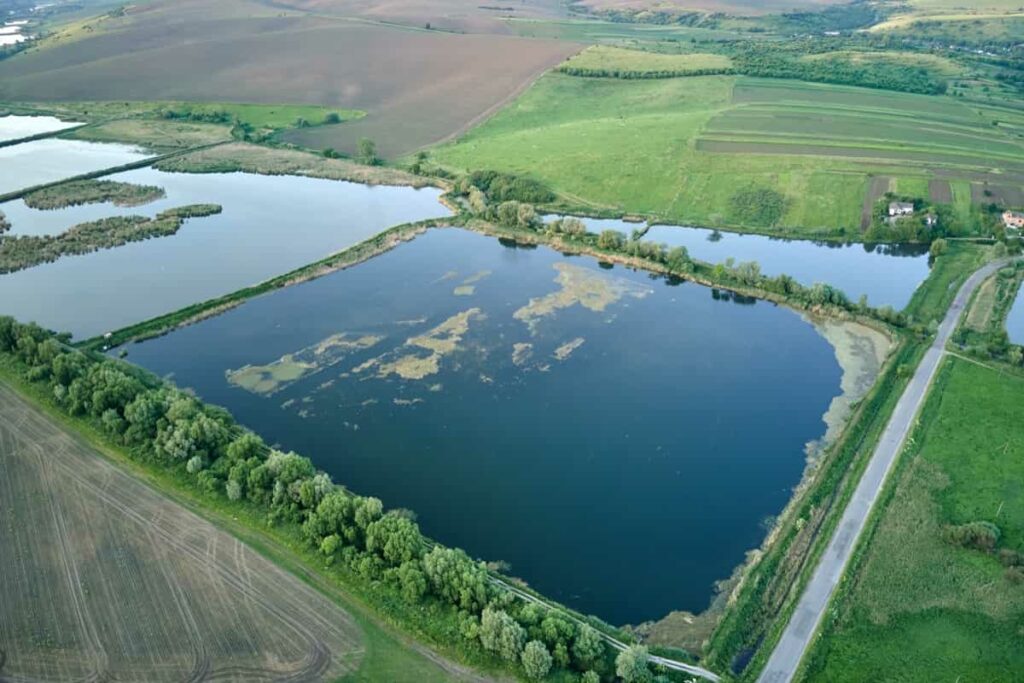A farm pond is a small body of water designed to collect and store rainwater for various agricultural and livestock farming uses. Building a farm pond in India has become increasingly popular due to its many benefits. Farm ponds can be used for irrigation, livestock watering, fish farming, recreation, and aesthetics.

They help to conserve water, reduce dependence on monsoon rains, increase crop yields, and improve soil health. However, building a farm pond can be expensive, so the Indian government offers subsidy schemes to help farmers. Farmers can build farm ponds for a sustainable future by using these subsidies.
Building a Farm Pond in India
What is Farm Pond?
Farm ponds are small reservoirs or tanks that store rainwater from surface runoff. They have a range of uses, including irrigation, water supply for livestock, and fish farming. Constructing multiple ponds in a catchment can help reduce downstream flood flows. In areas of rainfed agriculture, farm ponds are crucial for storing water during the rainy season and using it for irrigation later on. Designing and building farm ponds requires careful consideration of site conditions and requirements.
Uses and Importance of a Farm Pond
- Irrigation: Farm ponds can irrigate crops, reducing farmers’ dependence on unpredictable monsoon rains and improving crop yields.
- Livestock watering: A farm pond can provide a reliable water source for livestock, reducing the need for expensive and time-consuming manual water transport.
- Fish farming: Farm ponds can be used for raising fish, providing an additional source of income for farmers.
- Recreational purposes: Farm ponds can be used for swimming, boating, and other recreational activities.
- Aesthetic purposes: Farm ponds can enhance the beauty of the landscape, providing a picturesque setting for the farm.
In case you missed it: Ginger Farming Business Plan: A Comprehensive Guide for Successful Profitable Cultivation and Harvesting

Advantages of Building a Farm Pond
- Water conservation: A farm pond can collect and store rainwater, reducing the reliance on monsoon rains and providing a reliable water source for crops and livestock.
- Improved crop yields: Irrigation with pond water can improve crop yields and reduce water usage.
- Soil health: Farm ponds help to reduce soil erosion, improving soil health and preventing nutrient loss.
- Flood mitigation: Farm ponds can help to mitigate flood risks by storing excess water during heavy rainfalls.
- Additional income: Farm ponds can be used for fish farming, providing an additional source of income for farmers.
Types of Farm Pond
- Dugout ponds or excavated ponds are created by excavating soil on-site and using it to form an embankment around the pond. The pond can be fed by surface runoff or groundwater.
- Surface ponds or watershed ponds – these ponds are partially excavated, with an embankment constructed to hold the water. They are fed by surface runoff from the pond’s catchment area.
- Spring or creek-fed ponds: These ponds are supplied with water from natural springs or streams. The pond’s construction depends on the availability of these natural water sources.
Components of Farm Pond
A farm pond consists of a storage area, an earthen dam, a mechanical spillway, and an emergency spillway. The mechanical spillway is used to let out excess water and as an outlet for irrigation. The emergency spillway prevents the earthen dam from overtopping during high inflows. Designing a farm pond involves selecting a site, determining its capacity, and designing the embankment, mechanical spillway, emergency spillway, and seepage control.
In case you missed it: A Comprehensive Guide to Saffron Farming Business Plan: Maximizing Your Harvest, Successful Saffron Farming Strategies

How to Build a Farm Pond Step by Step for Commercial
- Select the site: Choose a place with a narrow valley section with steep side slopes to ensure the largest storage volume with the least amount of earth fills. Large expanses of shallow water should be avoided as they promote the growth of water weeds and result in excessive evaporation losses. The pond should be situated as close as feasible to the area where the water will be used, and the site shouldn’t result in excessive seepage losses.
- Design the pond: A contour study of the area calculates the pond’s capacity. The capacity for various phases is determined from the site’s contour plan using the trapezoidal or Simpson’s rule. A planimeter measures the area that each contour encloses for this purpose. The estimated depth-capacity data displays a reservoir depth-capacity curve for various altitudes. The outlet and spillway construction should be planned to release water from the storage in a controlled manner.
- Excavate the pond: Excavate the pond according to the design. Excavating up to 30 cm is sufficient if the soil is well-graded at the bottom of the pond (about 70% sand, 20% clay, and 10% silt). If not, lining the pond will be required.
- Construct the embankment: Construct the embankment to hold the water in the pond. The embankment should be built using the soil excavated from the pond. The embankment should be at least 1.5 times the maximum water depth.
- Construct the spillway and outlet structures: The spillway and outlet structures should be constructed according to the design. The embankment-type pond has a mechanical spillway to allow water from the storage to be released in a controlled manner. An emergency spillway is offered to prevent the embankment from overflowing because of unanticipated inflows into the storage.
- Fill the pond with water: Water from a local source should be pumped.
- Maintain the pond: To maintain the pond, it is necessary to control the growth of water weeds and prevent the accumulation of silt. This can be done by using chemicals or natural methods such as introducing fish or aquatic plants. Regular pond inspection is also important to detect and repair any leaks or damage to the embankment or spillway structures.
In case you missed it: Rosemary Farming Business Plan: A Step-by-Step Guide to Growing and Selling Profitable Herbs

How to Build a Farm Pond for Water Storage
- Choose a low-lying area: Select an area in your farm that is naturally low-lying and has good soil for digging a pond.
- Determine the ideal size: The optimal pond size is 10 meters by 10 meters by 3 meters deep. The pond must be large enough to hold roughly half of the maximum runoff to fill up even during drought.
- Dig the pond: Dig the pond to the desired depth, and use the removed soil to construct an earthen berm around the pond. For stability, the pond’s sides should slope.
- Create an inlet and an outlet: The pond should have an inlet and an outlet lined with rock to prevent erosion. These features must be linked into a larger drainage plan that directs water into the pond and receives overflow water.
- Consider lining the pond: It could be required to line the pond to lessen permeability if the objective is to preserve conveniently accessible surface water in the pond for water demands. Clay, stone or brick, cement, rubber, bentonite, , plastic, etc. are all potential lining materials.
- Consider adding a settling pit: Small settling pits at the inlet can be cleaned more quickly and readily than the entire pond, aiding in silt removal.
- Plant vegetation around the pond: The earthen berm around the pond should be planted with trees and grasses for stability. The shade and wind protection the raised mound and vegetation provide will reduce evaporative losses.
- Consider the pond’s function: Choose whether you want to encourage water infiltration or keep the pond’s surface water accessible for water needs. An agricultural pond can support fish growth if it maintains moisture for 80% of the year.
Cost of Building a Farm Pond
- The cost of building a farm pond with top dimensions of 25 m x 25 m and a depth of 3 m, with 1.5:1 side slopes and a capacity of 1765 cubic meters, can be estimated.
- For the excavation of soil, the cost per cubic meter is Rs 26.06 (calculated as the cost for the excavation of soil for the 27.5 x 27.5 m pond divided by its capacity). Therefore, the cost for the excavation of soil for the 25 m x 25 m pond is approximately Rs 48,955 (1765 m³ x Rs 26.06/m³).
- The cost per square meter of 500-micron plastic for lining is Rs 58.40 (calculated as the cost of lining for the 27.5 x 27.5 m pond divided by its area). Therefore, the cost of lining for the 25 m x 25 m pond is approximately Rs 86,000 (1476.25 m² x Rs 58.40/m²).
- The cost of construction of the inlet may vary depending on the type of inlet chosen. Based on the given data, the cost of the inlet for the 25 m x 25 m pond can be assumed to be Rs 15,000.
- For anchoring the lining, the cost per square meter is Rs 11.63 (calculated as the labor cost for anchoring the lining for the 27.5 x 27.5 m pond divided by its area). Therefore, the labor cost for anchoring the lining for the 25 m x 25 m pond is approximately Rs 19,316.25 (1661.25 m² x Rs 11.63/m²).
- Adding up all the costs, the estimated total cost of building a farm pond of 25 m x 25 m can be Rs 1,69,271.25.
In case you missed it: Goat Farming Project Report: Investment, Profit for 10, 20, 50, 100, and 500 Goats

| Component | Price (INR) |
| Excavation of soil | 48,955 |
| Lining | 86,000 |
| Construction of inlet | 15,000 |
| Labour cost for anchoring the lining | 19,316.25 |
| Total cost | 1,69,271.25 |
Note: It’s important to note that the above cost is an estimate and can vary based on various factors such as the availability and cost of materials, equipment, and labour in the specific location. Additionally, other components such as outlet structures, spillways, and filters may also need to be considered depending on the specific requirements of the farm pond.
Subsidy Schemes for Building a Farm Pond in India
Pradhan Mantri Krishi Sinchai Yojana (PMKSY): This is a flagship scheme of the government of India, aimed at providing end-to-end solutions in the irrigation supply chain, water distribution, and farm water management. Under this scheme, farmers can avail up to 55% of the cost of farm pond construction, up to a maximum of Rs. 50,000 per pond.
Rashtriya Krishi Vikas Yojana (RKVY): This scheme is implemented by the central government to provide financial assistance to states to increase the production and productivity of crops. Under this scheme, farmers can avail up to 50% of the cost of farm pond construction, up to a maximum of Rs. 1 lakh per pond.
Mahatma Gandhi National Rural Employment Guarantee Act (MGNREGA): This rural employment guarantee scheme aims to provide at least 100 days of wage employment to every rural household. Under this scheme, farmers can avail up to 90% of the cost of farm pond construction, up to a maximum of Rs. 1.50 lakh per pond.
State government schemes: Several states in India have also launched their schemes to encourage farmers to build farm ponds. For example, the Telangana government has launched the “Mission Kakatiya” scheme, under which farmers can avail up to 90% of the cost of farm pond construction, up to a maximum of Rs. 2.5 lakh per pond.
Case Study of Subsidy Schemes for Building a Farm Pond
The Rajasthan government has initiated the Kisan Farm Pond Scheme to address farmers’ water scarcity issues. Under this scheme, eligible farmers can receive financial aid up to Rs. 90,000 to build a pond in their fields to collect rainwater for agricultural purposes. The scheme offers two types of support – the first is for a completely new pond that can hold up to 1200 cubic meters of water, and the second is for preparing a pond to collect rainwater.
The latter option helps save water for a longer period, ensuring that farmers do not face any irrigation water crisis in the future. All categories of farmers are eligible for this scheme, with 60% of the cost covered by the Agriculture Department of Rajasthan. The maximum amount of financial help that can be granted is Rs. 63,000 for a new pond and Rs. 90,000 for a pond with plastic lining work (300 microns as per the BIS norms). The minimum cultivable holding land should be 0.3 hectares, and farmers cultivating the land under a lease agreement for at least seven years are eligible for the scheme. Required documents include:
- An Aadhar Card
- Bhamasha Card
- Land Identity Card (Khata Khesra)
- Bank Account Number
- A copy of Jamabandi (a maximum of six months old)
Farmers can apply for the scheme by visiting their nearest Citizen Service Center or E-Mitra Center and submitting the original signed application and the required documents. The applicant will complete the original application form online and scan and upload the necessary documents.
In case you missed it: Pig Farming Project Report: Investment, Profit for 10, 20, 50, 100, and 500 Pigs/Hogs

The receipt for the online submission of the application form will be available online, and the original documents will have to be sent by post to the office of the concerned Agriculture Department. Contacting the concerned agriculture office at the district level or the Assistant Agriculture Officer at the Panchayat Samiti level can help farmers benefit from the Kisan Farm Pond Scheme.
Conclusion
Building farm ponds in India can help maximize the use of rainwater for agricultural purposes, resulting in increased crop yield and reduced dependence on groundwater. With the government’s Kisan Farm Pond Scheme offering financial assistance, farmers can benefit from building a pond while contributing to water conservation efforts.
- How to Raise Pigs in Your Own Backyard: A Comprehensive Guide
- Budget Friendly Sheep Shed Ideas: Cheap and Low-Cost Tips
- How Much Do Cattle Farmers Make: Revenue Streams in Cattle Farming
- Management Pests and Diseases in Your Cotton Field
- Sheep Farming Business Plan for Beginners
- Aquaponic Farming at Home: A Step-By-Step Guide
- Profitable Village Farming Business Ideas in 2024
- High-Yield Aquaculture: Fast-Growing Fish for Farming
- Effective Fish Pond Construction Techniques for Beginners
- Irrigation and Water Management in Pineapple Farming
- Blossom to Harvest: Mastering Flowering and Pollination in Papaya Farming
- Pig Fattening Essentials: From Selection to Sale for Beginners
- Raising Wagyu Cattle: A Complete Guide for Premium Beef Production
- Soil Types and Their Water Holding Capacity
- Optimizing Irrigation Schedules for Coconut Groves for Enhanced Yield
- Espresso Your Garden: Coffee Grounds for Healthier Acid-Loving Plants
- The Best Soil Mix for Snake Plants: How to Mix Your Own Snake Plant Soil
- Green Thumb Success: Expert Tips for Cultivating Greenhouse Beans All Year Round
- Bloom All Year Round: The Ultimate Guide to Indoor Hyacinth Care
- Eco-Friendly Gardening: How to Make Liquid Fertilizer from Kitchen Waste
- Ultimate Guide to Grow Anise in Pots: Explore Seed Propagation to Harvesting
- Guide to Raising Chester White Pigs: Discover Breed Facts to Growth Management
- Mastering the Elegance: The Ultimate Guide to Weeping Cherry Tree Care, Planting, and Maintenance
- Ultimate Guide to Planting Garlic in Grow Bags: Growing Strategies for Beginners
- How to Fix Spider Plant Leaf-Related Problems: Natural and Organic Remedies
- 10 Reasons Why Your Tulsi Plant is Shedding Leaves: Home Remedies and Solutions
- Optimizing Growth and Yield: The Advantages of Palm Bunch Ash Fertilizer
- Utilizing Neem Oil Extract as a Natural Pesticide for Hydrangea
- From Soil to Harvest: Various Ways in Which Farmers Can Use AI Tools
- Steps to Encourage and Induce Citrus Flowers: A Comprehensive Guide
- How to Fix Snake Plant Leaf-Related Issues: Natural and Organic Remedies
- Transform Your Garden into a Fragrant Oasis with Raat Ki Rani (Night Blooming Jasmine)
- Discover the Ideal Chicken Breeds for Philippine Farms
- How to Create a Poultry Egg Farm Business Plan for Profits
- Grow Lemon Cucumbers Like a Pro: Insider Techniques for Bountiful Yields
- Ultimate Guide to Caring for Your Pink Princess Philodendron: Tips for Thriving Variegation
